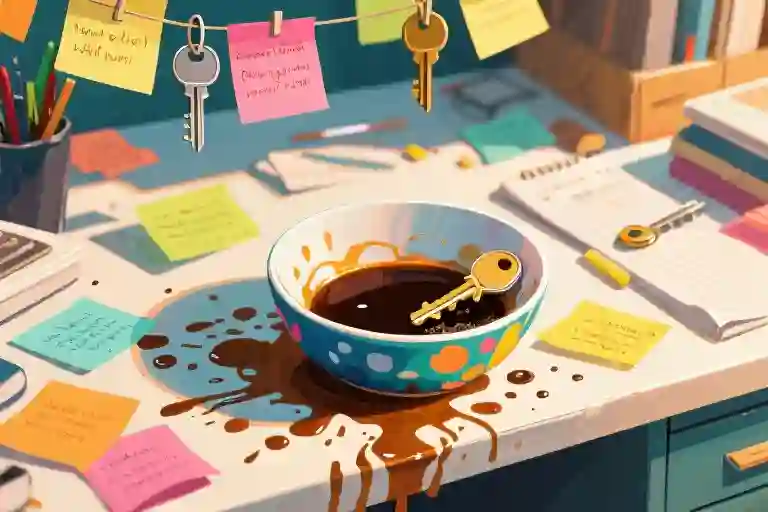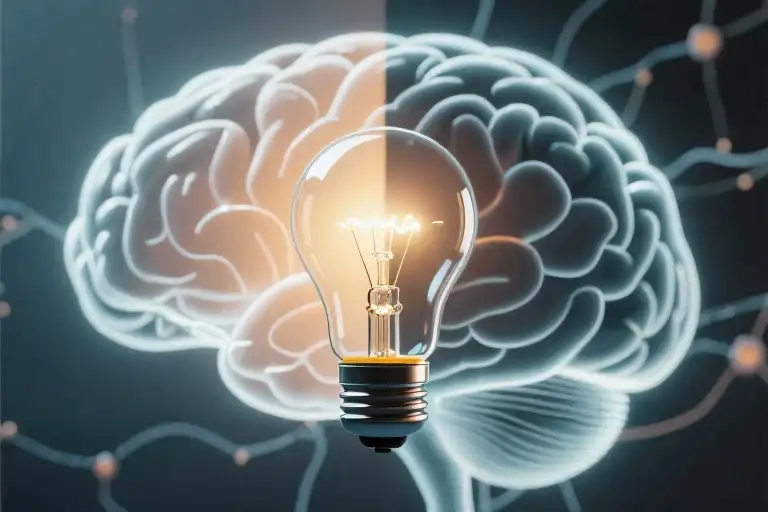The conference room clock ticked to 9:03 AM as I stumbled through the door, laptop bag strap tangled around my elbow, coffee sloshing onto the quarterly report. Three colleagues turned with synchronized eyebrow raises—the kind perfected by people whose brains don’t treat time as abstract art. Their 8:55 arrivals might as well have been magic tricks.
This wasn’t carelessness. My mornings were military operations with color-coded checklists, yet somehow I’d still end up sprinting past reception with one shoe half-tied. The real mystery wasn’t why I was late, but why everyone else wasn’t.
ADHD manifests in triple-feature matinees of absurdity:
- The Phantom Keys: Every flat surface became a Bermuda Triangle for essentials. My keychain had its own Missing Persons poster at the leasing office.
- Dialogue Blackouts: Mid-conversation, my train of thought would derail like a soap opera amnesia plot. Wait, were we discussing budgets or alpaca farming?
- Deadline Mirage: That project due Friday? My brain processed it as some future-Friday in a parallel universe until Thursday midnight panic set in.
For decades, I weaponized these incidents against myself—proof of moral laziness. The truth surfaced at 31: these weren’t failures of character but differences in neural wiring. What looked like chaos was my prefrontal cortex running on dial-up while others had broadband.
That coffee-stained morning wasn’t professional negligence—it was neurodivergence in action. The realization didn’t erase challenges, but it transformed shame into something far more dangerous: self-compassion.
When Daily Life Becomes an Obstacle Course
Time blindness isn’t just about running late – it’s living in an alternate dimension where clocks operate on whims rather than rules. That ‘quick shower’ I swear will take 30 minutes? Two hours vanish before I realize the water’s gone cold. My brain processes time like a toddler finger-painting with numbers, smudging 5 minutes into what feels like 20, stretching afternoon meetings into what might as well be geological eras.
The real magic trick? Hyperfocus. One evening I sit down to code at 8PM and suddenly it’s noon the next day, my bladder screaming while my fingers keep dancing across the keyboard. Yet ask me to reply to a three-line email and it might as well be translating Sanskrit while juggling chainsaws. This neurological seesaw means I’ve both shipped entire projects in record time and missed basic deadlines because opening my inbox felt physically painful.
Then there’s the emotional rollercoaster no one warned me about. A coworker’s offhand comment about ‘prioritization’ can echo in my skull for weeks, each replay intensifying the sting. Rejection sensitivity dysphoria isn’t just being thin-skinned – it’s like having emotional nerve endings on the outside of your body, where every interaction leaves either fireworks or third-degree burns. I’ve canceled weekend plans over a text message that probably wasn’t even negative, my brain helpfully supplying 47 worst-case interpretations.
These aren’t personality flaws or moral failings. They’re the telltale glitches of an ADHD operating system trying to run in a neurotypical world. The time blindness stems from dopamine-starved brain circuits struggling to gauge duration. The hyperfocus happens when understimulated prefrontal cortex finally latches onto something rewarding. The emotional turbulence comes from amygdala hypersensitivity – our threat detection system stuck in overdrive.
What looks like carelessness is actually a constant negotiation with a brain that works differently. My keys aren’t lost because I’m irresponsible, but because working memory glitches make object permanence a theoretical concept. That unfinished project isn’t abandonment – it’s task paralysis from a overwhelmed executive function system. Understanding these mechanisms doesn’t erase the challenges, but it transforms them from character indictments into manageable conditions.
Living with ADHD means accepting that some tools will never fit our mental hands. Planners with perfect hourly blocks? Might as well be written in hieroglyphics. But when I discovered time-tracking apps that visualize duration as color blocks, or realized breaking tasks into ‘stupid small’ steps bypassed my brain’s resistance, suddenly ‘lazy’ became ‘differently motivated’. The obstacles didn’t disappear, but I started seeing detours where before I’d only seen dead ends.
The Twenty-Year Misdiagnosis Odyssey
School report cards told the same story year after year: “Bright but careless.” Teachers saw potential buried under forgotten homework assignments and half-finished projects. What no one recognized were the classic signs of undiagnosed ADHD in a gifted child – the hyperfocus on fascinating topics paired with utter inability to study boring subjects, the brilliant classroom contributions followed by failing grades on trivial administrative tasks.
My academic survival depended on two coping mechanisms that would later become familiar ADHD trademarks: last-minute panic motivation and elaborate compensatory systems. I developed an entire taxonomy of excuses for lost permission slips (the dog theory, the washing machine defense, the mysterious backpack vortex). When forced to sit still, I’d methodically peel layers of skin from my lips until they bled – what psychologists now call body-focused repetitive behaviors, common in neurodivergent individuals trying to regulate their nervous systems.
The workplace transformed these childhood struggles into full-blown crises. Over seven years, I cycled through jobs like a character in occupational musical chairs – the graphic design position abandoned when client revisions triggered task paralysis, the teaching job resigned after grading papers induced actual nausea, the corporate role that ended when my brain simply refused to process another spreadsheet. Each departure followed the same pattern: initial hyperfocus honeymoon period, gradual erosion of executive function, and eventual collapse under the weight of uncompleted mundane tasks.
What looked like professional flakiness from the outside felt internally like being trapped in a cognitive funhouse. I’d spend hours perfecting irrelevant presentation fonts while missing critical deadlines, or compose eloquent emails to avoid making simple phone calls. Colleagues interpreted this as laziness rather than what it was – my brain’s faulty prioritization system assigning equal urgency to “reply to client” and “research 19th century typesetting techniques.
When chronic underachievement led to depression, the mental health system provided another layer of misdirection. Well-meaning therapists treated surface-level anxiety while missing the root cause. Antidepressants smoothed out mood swings but exacerbated focus issues – like putting frosting on a collapsing cake. The breakthrough only came when a psychiatrist finally asked the right question: “Have you ever considered that your depression might be secondary to untreated ADHD?”
That moment of recognition contained both profound relief and simmering anger – at the educational system that pathologized my learning style, at workplaces that mistook neurological differences for moral failings, and at years spent internalizing these false judgments. The diagnosis didn’t erase past struggles, but it gave me something far more valuable: the vocabulary to finally understand my own mind.
Looking back, the clues were always there, hiding in plain sight like my perpetually misplaced keys. The real mystery wasn’t my behavior, but why it took twenty years for anyone to connect the dots.
The Science That Explained My Brain
The TOVA test screen flickered in the dimly lit clinic room, its repetitive prompts designed to expose what my school reports had called ‘carelessness’ and my employers labeled ‘inconsistent performance.’ As the beeps grew monotonous, I noticed my focus drifting to the technician’s squeaky shoes—until the abrupt silence revealed I’d missed seven consecutive targets. The printout showed my brainwaves dancing to their own rhythm: theta waves (the daydreamers) outnumbering beta waves (the taskmasters) by three to one.
When the psychiatrist laid the DSM-5 criteria between us, I experienced the surreal sensation of reading my biography in clinical jargon. Eight of the nine adult ADHD markers mirrored my life’s frustrating patterns—the forgotten appointments, the half-finished projects, the mental traffic jams when deciding what to eat for breakfast. Item A2 (‘Often avoids tasks requiring sustained mental effort’) alone explained my abandoned graduate thesis and twelve barely-started language learning apps.
What finally shattered my shame came through a simple analogy. ‘Having ADHD,’ the doctor said while adjusting her glasses, ‘is like having 20/200 vision in a world that only sells standard prescription lenses. No amount of squinting will make the blur go away.’ She tapped my test results: ‘Your brain isn’t broken—it’s differently calibrated. We just need to find your cognitive corrective lenses.’
That framing changed everything. The same neural pathways that made me lose three umbrellas in a month also enabled hyperfocus that could solve complex coding problems in single sittings. The time blindness causing chronic lateness? Just my internal clock running on geological time. For the first time, my struggles weren’t moral failures but predictable interactions between my neurochemistry and environments designed for linear thinkers.
The diagnosis didn’t erase challenges, but it gave me the decoder ring for my own mind. When I now forget why I entered a room, I recognize it as a working memory glitch rather than early dementia. When emails pile up unanswered, I understand it’s task paralysis, not laziness. Most importantly, I’ve stopped wasting energy trying to ‘fix’ myself into neurotypical standards, and started designing systems that work with—not against—my brain’s unique operating system.
Living with ADHD: Practical Strategies That Actually Work
After years of feeling like I was fighting my own brain, my ADHD diagnosis finally gave me the vocabulary to understand why traditional productivity advice never stuck. The real breakthrough came when I stopped trying to force my neurodivergent mind into neurotypical systems and started designing solutions around how my brain actually functions.
Spatial Anchoring for the Chronically Disorganized
Losing my keys used to be a daily ritual – I’d pat my pockets in panic while late for meetings, only to find them dangling from the refrigerator door where I’d left them while grabbing breakfast. The game-changer was implementing what I now call “spatial anchoring.” Every high-loss item now has a designated home: a bowl by the door for keys, a specific jacket pocket for my wallet, and a charging station that’s become my phone’s gravitational center. Adding Bluetooth trackers to these essentials created a safety net for those days when even the best systems fail. It’s not foolproof, but it’s reduced my frantic searches by about 80%.
Making Time Tangible
Digital clocks might as well be abstract art for someone with ADHD time blindness. Those blinking numbers never translated to my brain’s perception – I’d swear I spent “five minutes” showering when the clock insisted it was forty. Switching to physical timekeepers changed everything. A simple sand timer on my desk creates visible time passage for short tasks, while color-changing smart bulbs gradually shift hues as deadlines approach. For appointments, I set two alarms: one labeled “LAST CHANCE TO LEAVE” calculated with Google Maps transit time plus a 15-minute ADHD buffer, and another titled “YOU’RE LATE” for absolute cutoff.
Emotional First Aid for RSD Episodes
Rejection sensitive dysphoria hit me hardest at work – a mildly critical email could send me spiraling for days. My therapist suggested creating an “emotional buffer zone” using timed journaling. When I feel that familiar heat rising after perceived criticism, I set a 15-minute timer and freewrite everything I’m feeling without censorship. More often than not, the act of externalizing those thoughts diminishes their power. If the distress persists after the timer, I have a pre-written list of trusted people to reach out to for reality checks. This practice hasn’t eliminated RSD, but it’s given me tools to prevent emotional avalanches from derailing entire weeks.
What surprised me most wasn’t that these strategies worked, but how radically my self-perception shifted once I stopped viewing ADHD as something to overcome and started treating it as a different operating system needing customized programming. The goal stopped being “normal” productivity and became sustainable functionality on my own terms.
Finding Your Tribe and Tools
The moment my psychiatrist slid the ADHD assessment results across the table, something unexpected happened – I didn’t feel broken. For the first time, I saw my brain’s chaotic wiring not as personal failures but as neurological differences needing accommodation. That reframing changed everything.
#ADHack Community Wisdom
What surprised me most post-diagnosis was discovering how many others shared my peculiar struggles. There’s dark comfort in hearing strangers describe your exact thought patterns:
- The ‘five more minutes’ lie we tell ourselves that magically becomes three hours
- That special panic when someone asks ‘what are you thinking about?’ and your mental browser has 47 tabs open
- The mysterious black hole where left shoes and phone chargers disappear
Online communities became lifelines. The ADHD subreddit’s memes made me snort coffee through my nose with recognition. Twitter threads about ‘object permanence issues’ (read: forgetting vegetables exist until they liquefy in the fridge) made me feel seen. These spaces taught me more practical coping mechanisms than any medical pamphlet.
Curated Survival Kit
Through trial and spectacular error, these resources rose to the top:
How to ADHD YouTube channel – Jessica’s ‘Wall of Awful’ episode explained my procrastination cycles better than twelve years of therapy. The visual breakdown of dopamine’s role in task initiation was a game-changer.
ADDitude Magazine’s workplace guides – Their ‘Body Doubling’ article helped me finally understand why I could write reports easily in coffee shops but stared blankly at my home office wall. Turns out, ambient stranger pressure is my productivity fuel.
Trello for visual thinkers – Color-coded lists with progress columns stopped my to-dos from existing solely in anxious mental loops. The satisfaction of dragging a card to ‘Done’ gives my brain the mini dopamine hit it craves.
Beyond Coping to Thriving
The real breakthrough came when I stopped trying to ‘fix’ myself into neurotypical standards. My therapist drew a simple diagram that stuck with me – two columns labeled ‘Can’t Change’ (brain wiring) and ‘Can Adapt’ (environment, tools, self-talk). We spent months moving items from the first column to the second.
Now I keep a running list of what I call ‘Brain Owner’s Manual’ notes:
- Section 3.1: Time Estimation – Always multiply intended duration by 2.5
- Section 5.7: Decision Fatigue – Pre-choose weekly meals/outfits during high-spoon days
- Appendix B: Emergency Protocols – Forgot meds? Caffeine + protein + instrumental music
This manual keeps evolving. Last month I added a new footnote after discovering brown noise helps my concentration better than silence or music. Next week I might learn another hack from someone in the comments.
So tell me – what’s in your Brain Owner’s Manual? What #ADHack changed your daily grind? The collective wisdom of our beautifully weird brains could fill libraries, and I’m here taking notes.





